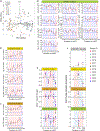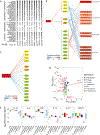Translocated microbiome composition determines immunological outcome in treated HIV infection
- PMID: 34237254
- PMCID: PMC8316372
- DOI: 10.1016/j.cell.2021.05.023
Translocated microbiome composition determines immunological outcome in treated HIV infection
Abstract
The impact of the microbiome on HIV disease is widely acknowledged although the mechanisms downstream of fluctuations in microbial composition remain speculative. We detected rapid, dynamic changes in translocated microbial constituents during two years after cART initiation. An unbiased systems biology approach revealed two distinct pathways driven by changes in the abundance ratio of Serratia to other bacterial genera. Increased CD4 T cell numbers over the first year were associated with high Serratia abundance, pro-inflammatory innate cytokines, and metabolites that drive Th17 gene expression signatures and restoration of mucosal integrity. Subsequently, decreased Serratia abundance and downregulation of innate cytokines allowed re-establishment of systemic T cell homeostasis promoting restoration of Th1 and Th2 gene expression signatures. Analyses of three other geographically distinct cohorts of treated HIV infection established a more generalized principle that changes in diversity and composition of translocated microbial species influence systemic inflammation and consequently CD4 T cell recovery.
Keywords: HIV; antiretroviral therapy; inflammation; microbiome; systems biology.
Published by Elsevier Inc.
Conflict of interest statement
Declaration of interests The authors declare no competing interests.
Figures






References
-
- Acosta-Rodriguez EV, Napolitani G, Lanzavecchia A, and Sallusto F (2007). Interleukins 1beta and 6 but not transforming growth factor-beta are essential for the differentiation of interleukin 17-producing human T helper cells. Nat Immunol 8, 942–949. - PubMed
-
- Bettelli E, Carrier Y, Gao W, Korn T, Strom TB, Oukka M, Weiner HL, and Kuchroo VK (2006). Reciprocal developmental pathways for the generation of pathogenic effector TH17 and regulatory T cells. Nature 441, 235–238. - PubMed
Publication types
MeSH terms
Substances
Grants and funding
LinkOut - more resources
Full Text Sources
Medical
Molecular Biology Databases
Research Materials

